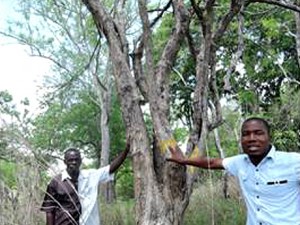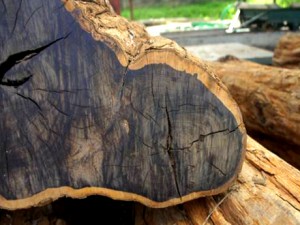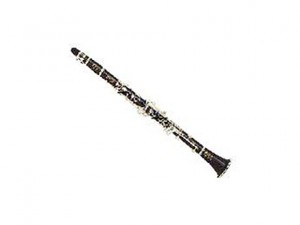African blackwood



Source plants
- scientific name
- Dalbergia melanoxylon Guill. & Perr.
- general name
- African blackwood(African ebony, African grenadillo, African ironwood, Senegal ebony, Zebra wood)
- overview
-
African blackwood is a tree belonging to the family Fabaceae, distributed in Sub-Saharan Africa, mainly in Tanzania and Mozambique. It is divided into milky-white sapwood and blackish-brown heartwood. The heartwood is hard and less sensitive to humidity so that it is used for woodwind instruments, furniture, sculptures, and others.
It has been in high demand and cut down as a precious material. However, the growth is so slow that it takes 70-100 years until it reaches a size to be harvested, and the decrease in the stock is significant. In the IUCN Red List, it is classified as Near Threatened, and conservation and sustainability are necessary.
Product characteristics
- use
- Crafts, musical instruments, furniture
- area
- Sub-Saharan Africa such as Tanzania and Mozambique
- overview
-
High value goods
African blackwood consists of heartwood and sapwood. Heartwood is very dark brown to dark purple. It is used for crafts such as sculptures, chess pieces, and knife handles and furniture as well as woodwind instruments such as clarinets and oboes as it is high in density and close-grained so it produces clear, beautiful and stable sound.
It is an extremely high specific gravity material. The specific gravity of sapwood is about 1.18 and that of heartwood with moisture content of 12% is 1.2-1.3. With such a high specific gravity, it is likely to crack during seasoning due to the moisture content gradient between the surface and the inside of the wood. Therefore, it is naturally seasoned for at least three years. The seasoned wood has extremely stable properties. It is very resistant to changes in weather and is very hard. Therefore it is necessary to use a tungsten carbide blade to process the wood. As seen from the above, processing takes a lot of time, cost, and technique.
Also, in many cases, logs are of a diameter as small as 20 cm or less, and are crooked and twisted, so lumber yield rate is low and a large amount of waste wood is generated. The percentage of exported lumber is, in Tanzania, only about 9%.
Export and import trends, demands in Japan
The international trade volume of the wood is small, but the price is very high. The export value of semi-processed African blackwood was estimated to be 2-3 million USD as of 2002. The main exporter was Tanzania, and the average annual export volume was 73.5 m3 from 1999 to 2000. African blackwood was exported mostly in the form of small-size billets, and the average price was 10,900 USD/m3 in 2000. As for use as a material for musical instruments, it is often traded for 18,000 or more USD/m3 to musical instrument manufacturers primarily in Europe and America (Jenkins et al., 2002).
In the past, much African blackwood was produced in Malawi and Kenya, but production has been decreasing due to preliminary evaluation as an endangered species by law and with the reduction in the resource amount. In Tanzania, there are also growing concerns that the commercial use of this tree will become difficult in the near future. Although the international trade at the moment is stable, there is the possibility that the market will soar. Development of production methods and sustainable harvesting methods are needed.
Main importers are European countries (about 70%), Asian countries (20%), and the U.S.A. (10%)
Market prospects and issues to be addressed
Being of high value, it has been over-logged, and a decrease in the resource amount and destabilization of the international market are expected. For this reason, there is instability in terms of the stable procurement by musical instrument manufactures and so on (Hamisy and Hantula, 2002; Jenkins et al, 2002). However, including Tanzania, which is one of the major production countries, the statistics on the accumulated resource amount are undeveloped, and it is difficult to understand the current situation regarding the resource. In addition, for musical instrument materials, the supply routes are uncertain in many cases.
Therefore, collecting information on resource production such as research on development of sustainable harvesting methods in producing countries, growth rate, and propagation methods as well as gathering information on the production, processing, and supply of the material is necessary.
- references
-
- Ball, S.M.J., 2004. Stocks and exploitation of East African blackwood Dalbergia melanoxylon: a flagship species for Tanzania’s miombo woodlands? Oryx 38(3): 266–272.
- Bolza, E. & Keating, W.G., 1972. African timbers: the properties, uses and characteristics of 700 species. Division of Building Research, CSIRO, Melbourne, Australia. 710 pp.
- FAO
- Hamisy, W.C., & Hantula, J., 2002. Characterization of genetic variation in African Blackwood, Dalbegia melanoxylon using random amplified microsatellite (RAMS) method. Plant genetic resources and biotechnology in Tanzania. Part, 1, 108-117.
- Jenkins, M., Oldfield, S. & Aylett, t. 2002. International Trade in African Blackwood. Fauna & Flora International, Cambridge, UK.


